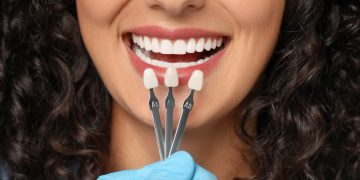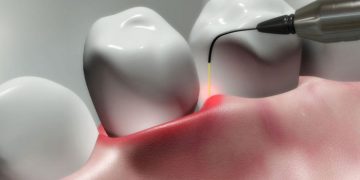Introduction
A bright, white smile is something many individuals desire, and teeth whitening has become one of the most popular cosmetic dental treatments worldwide. However, for people with gum disease, the question arises: Is teeth whitening safe? Gum disease, or periodontal disease, is a condition that affects the tissues surrounding the teeth, including the gums, ligaments, and bones. It is a common problem that can range from mild gingivitis to severe periodontitis, with varying symptoms such as swollen, bleeding gums, bad breath, and tooth mobility.
While teeth whitening can be an effective way to improve the appearance of your smile, individuals with gum disease may need to exercise caution before undergoing such procedures. The chemicals used in whitening treatments, particularly hydrogen peroxide, can sometimes irritate the gums or worsen existing conditions. This article will evaluate whether teeth whitening is safe for individuals with gum disease, the potential effects of whitening on the gums, and what options are available for those with compromised oral health. Additionally, professional advice on cosmetic procedures for gum disease sufferers will be discussed to help readers make an informed decision.
The Effects of Whitening Treatments on Gums
Teeth whitening treatments primarily rely on bleaching agents, such as hydrogen peroxide or carbamide peroxide, to break down stains and lighten the color of the enamel. While these agents are effective for whitening teeth, they can have different effects on gums, especially in individuals with gum disease.
1. Chemical Irritation and Sensitivity
The most common side effect of teeth whitening is increased tooth sensitivity, but people with gum disease may also experience irritation or discomfort in the gums. The chemicals used in whitening treatments can irritate the soft tissues of the gums, leading to inflammation, redness, and swelling. If the gums are already compromised due to gum disease, they may be more sensitive to these chemicals, which could exacerbate existing symptoms of gingivitis or periodontitis.
Moreover, whitening agents are usually applied to the teeth using custom trays or strips. If the trays do not fit well or if there is leakage of the whitening solution onto the gums, it can lead to chemical burns or irritation, further worsening gum health. In severe cases, this irritation can contribute to the deterioration of gum tissue, making it harder to treat gum disease effectively.
2. Risk of Compounding Gum Issues
Individuals with gum disease already have weakened gum tissue that may be more prone to damage. Whitening treatments, if not done properly, can aggravate these issues. For example, people with gum disease may have receded gums, exposing the tooth roots. The exposed root surfaces are more sensitive and vulnerable to the harsh chemicals in whitening agents. In addition, if the gum disease has caused pockets to form between the gums and teeth, whitening solutions may seep into these areas, causing further discomfort and irritation.
While these side effects are generally temporary, they can make the process of whitening more uncomfortable for those already dealing with gum disease. It is crucial for individuals with gum disease to consult with a dentist before deciding to proceed with teeth whitening.
3. Possible Effect on Gum Healing
Whitening treatments can also affect the healing process of gums that have undergone treatment for gum disease. For instance, after undergoing a professional deep cleaning (scaling and root planing) to treat gum disease, it’s essential for the gums to heal before any whitening procedures are performed. Using bleaching agents during this healing phase could delay recovery or cause additional irritation, potentially increasing the risk of further gum recession or infection.
Treatment Options for Those with Gum Disease
For people with gum disease who are interested in whitening their teeth, it is important to consider treatment options that will not compromise their gum health. A few options include:
1. Consulting a Professional for Evaluation
Before considering teeth whitening, individuals with gum disease should first consult with a dentist or periodontist. A dentist can evaluate the severity of the gum disease, recommend appropriate treatments to improve gum health, and ensure that whitening treatments can be performed safely. For example, if someone has mild gingivitis, their dentist may recommend treating the gum disease first before proceeding with teeth whitening. For more advanced cases of gum disease, a dentist may advise against whitening treatments until the gums are fully healed and healthy.
2. Whitening for Sensitive Teeth
There are whitening treatments available that are specifically designed for individuals with sensitive teeth or gums. These treatments use lower concentrations of hydrogen peroxide or carbamide peroxide, which can minimize irritation to the gums. Additionally, some whitening systems contain desensitizing agents, such as potassium nitrate, that can help reduce tooth sensitivity and protect the gums from further irritation.

3. In-Office Whitening by a Professional
In-office teeth whitening, performed by a dental professional, is often safer for individuals with gum disease than at-home treatments. A dentist can ensure that the whitening gel is applied carefully, minimizing the risk of irritation. In-office whitening treatments also use stronger bleaching agents, which can produce faster and more predictable results. However, a dentist will first evaluate the health of your gums and teeth to determine whether this is a suitable option.
4. Home Whitening Kits with Supervision
For individuals who wish to whiten their teeth at home, there are professional-grade whitening kits that a dentist can provide. These kits typically use custom-made trays, which are tailored to the individual’s mouth to ensure a better fit and minimize leakage of whitening agents onto the gums. With a dentist’s guidance, these kits can be a safer option for those with gum disease, as they can be adjusted for sensitivity and monitored for side effects.
5. Natural Whitening Alternatives
For individuals with gum disease who are not suitable candidates for traditional whitening treatments, natural whitening alternatives may be an option. Some people choose to use baking soda or activated charcoal in small amounts as a natural way to whiten teeth. These methods are gentler on the gums and may help remove surface stains without causing significant irritation. However, these methods are generally less effective for significant discoloration and may not provide the dramatic results of professional treatments.
Professional Advice on Cosmetic Procedures for Gum Disease Sufferers
For those with gum disease, professional advice is essential before considering any cosmetic procedures, including teeth whitening. Dentists and periodontists can provide insights into the best approach to treatment, focusing on both cosmetic goals and overall oral health. Here are some professional guidelines to follow:
1. Treat Gum Disease First
One of the most important pieces of advice from dental professionals is to treat gum disease before considering any cosmetic procedures. Addressing the underlying health of your gums can prevent further complications and ensure that any whitening treatment you pursue is safe. Professional treatments like scaling and root planing or gum surgery may be necessary to restore gum health before whitening.
2. Monitor the Progress of Gum Healing
Once gum disease is treated, it is important to monitor the healing process. Regular dental check-ups can help ensure that your gums are healing properly and that they are strong enough to withstand whitening treatments. Once your gums are fully healed, you may be given the green light to proceed with whitening treatments, but only after a thorough evaluation.
3. Understand the Risks and Benefits
A professional will help you understand the risks and benefits of whitening treatments. They will ensure that you are fully informed about potential side effects, such as increased sensitivity or gum irritation, and help you choose the most appropriate treatment for your needs.
Conclusion
In conclusion, while teeth whitening can be an effective way to enhance the appearance of your smile, it may not be suitable for individuals with gum disease. The chemicals used in whitening treatments can irritate the gums and worsen existing symptoms of gum disease. It is essential for individuals with gum disease to consult with a dentist or periodontist before considering whitening procedures. A dentist can assess the severity of your condition and provide guidance on whether whitening treatments are safe, as well as recommend alternative options for achieving a whiter smile.
If you are considering teeth whitening and have gum disease, it is crucial to prioritize the health of your gums first. Treating gum disease and ensuring that your gums are fully healed before undergoing whitening treatments will help you achieve the best results without compromising your oral health. Always consult with a dental professional who can provide personalized recommendations based on your individual needs and oral health status.













































Discussion about this post